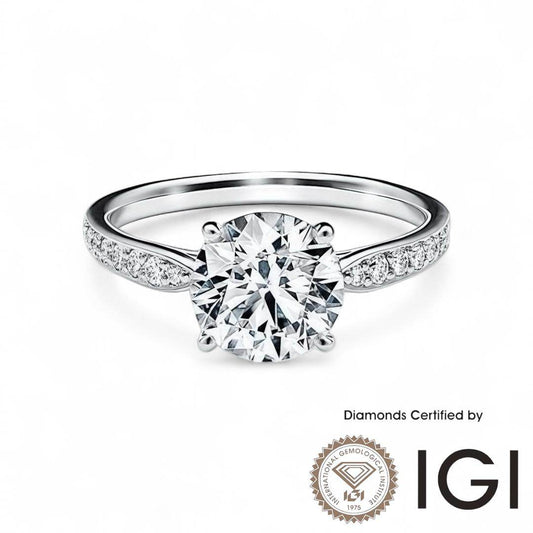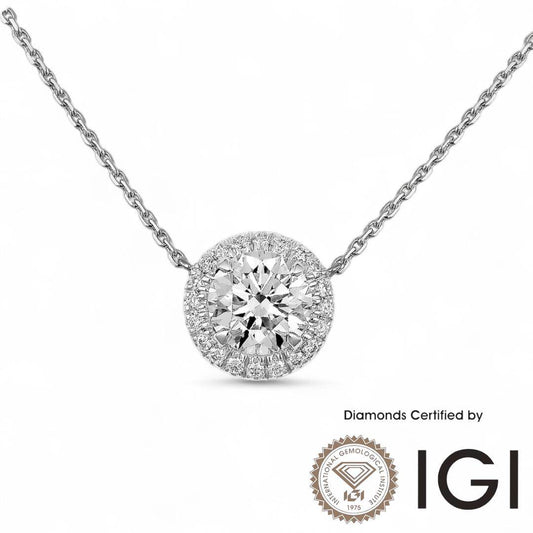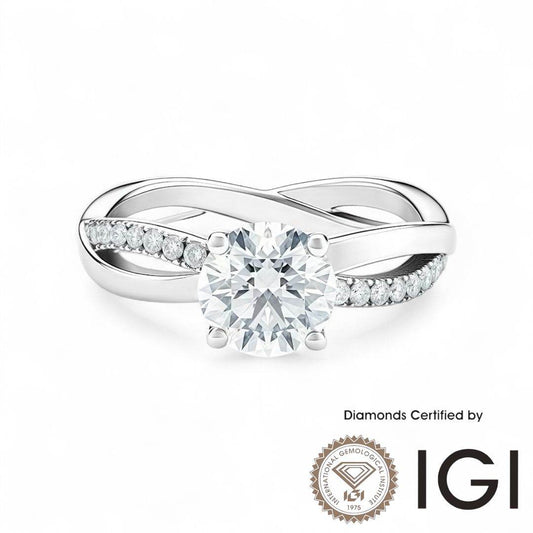How to Tell Diamond, Lab-Grown Diamond, Moissanite, and Cubic Zirconia (CZ) — The Easy Visual Guide
Updated: October 14, 2025
Author: MadisonDia — Gemstone Education
1. The Easiest Way — What You Can See With Your Eyes 👀 Diamond Sparks Within! Moissanite Sparks Outward
You don’t need a microscope or special tester to get your first clues. Even by eye, you can notice real differences if you know what to look for.
| Gem | What it looks like to the naked eye | Quick tip |
|---|---|---|
| Natural or Lab-Grown Diamond | Bright white sparkle with balanced fire (not overly colorful). Facets stay sharp even after years. | Looks clear, crisp, and elegant under light — not “rainbow flashy.” |
| Moissanite | Very sparkly, almost too colorful. You’ll see rainbow flashes of green, yellow, and blue when moving it under light. | If it feels like a “disco ball,” it’s likely moissanite. |
| Cubic Zirconia (CZ) | Super shiny when new, but may look slightly glassy. After some wear, it can turn cloudy or dull. | If the stone looks foggy or less sparkly over time — probably CZ. |
| Natural vs Lab Diamond | Completely identical by eye. | Only a gem lab (IGI, GIA) can confirm origin. |
Quick summary:
• Too much rainbow = Moissanite
• Perfect then cloudy = CZ
• Crisp and lasting shine = Diamond (natural or lab)
While both moissanite and diamond exhibit strong brilliance, the nature of their sparkle and light reflection patterns differ fundamentally due to variations in their optical properties, specifically their refractive index, double refraction, and dispersion rate.
1.2 Reflection Behavior
Moissanite tends to reflect more light off its surface (external reflection). This is because moissanite has a higher refractive index (2.65–2.69) compared to diamond’s 2.42. As a result, when sunlight hits the moissanite, a significant portion of the light bounces back outward before fully entering the stone. This causes moissanite to appear extremely shiny and white under direct sunlight, with a surface-level sparkle that can even seem “mirror-like” at certain angles.
Diamonds, on the other hand, are cut to maximize internal reflection — light enters the stone, bounces between internal facets, and then exits mainly through the table (the top surface). This creates the characteristic “inner fire” of a diamond — a depth-filled, concentrated brilliance that seems to come from within the stone rather than on the surface. The diamond’s sparkle tends to appear more focused at the crown and table area, rather than reflecting broadly across the entire surface.
1.2 Dispersion and Fire
Another major difference lies in dispersion, which measures how much white light is split into spectral colors (rainbow effect).
-
Moissanite’s dispersion is 0.104, nearly 2.5 times higher than a diamond’s 0.044.
-
This gives moissanite a stronger rainbow flash, often described as “fiery” or “colorful sparkle.”
-
Diamonds, by contrast, produce a more balanced brilliance — combining white light return (brilliance) and limited spectral fire — resulting in a clean, elegant shine rather than an overtly colorful one.
1.3 Visual Impression
To the human eye, this optical distinction creates two different impressions:
-
Moissanite often looks flashy, bright, and very reflective under sunlight or LED lighting — its sparkle can even appear too intense or “glassy” to those familiar with natural diamonds.
-
Diamond, by contrast, exhibits a softer yet deeper brilliance, where the light appears to originate from within the gem — a result of its precise internal light path and single refraction.
1.4 Summary of the Effect
| Property | Diamond | Moissanite |
|---|---|---|
| Refractive Index | 2.42 | 2.65–2.69 |
| Reflection Type | Mostly internal | Mostly surface + internal |
| Dispersion | 0.044 | 0.104 |
| Sparkle Color | White brilliance | Strong rainbow fire |
| Visual Depth | Deep, centered | Surface-level, outward |
| Under Sunlight | Controlled shine from top | Intense white shine all over |
In essence, the reason diamonds “shine from within” while moissanite “reflects outward” lies in how light behaves once it enters the stone. Diamonds are engineered for precision internal reflection, creating depth and understated brilliance. Moissanite, due to its higher refractive and dispersion properties, creates greater surface reflectivity and colorful flashes, giving it a dazzling yet less natural appearance under sunlight.
2. Why They Look Different — The Science Behind What You See
| Property | Diamond / Lab Diamond | Moissanite | Cubic Zirconia |
|---|---|---|---|
| Main element | Carbon (C) | Silicon carbide (SiC) | Zirconium dioxide (ZrO₂) |
| Hardness (Mohs) | 10 | 9.25 | 8–8.5 |
| Light effect | Balanced white sparkle | Strong rainbow “fire” | Bright but glassy, dulls over time |
| Durability | Lifetime brilliance | Long-lasting | Can get cloudy |
| Weight (same size) | Light | Slightly lighter | Heavier |
3. The Origin of Each Stone
| Type | Origin | How it forms |
|---|---|---|
| Natural Diamond | Earth’s mantle | Carbon crystallized over billions of years under pressure and heat. |
| Lab-Grown Diamond | Laboratory (HPHT or CVD) | Carbon atoms grow in a chamber replicating natural diamond conditions. |
| Moissanite | Lab-made (rarely natural) | Silicon carbide crystals grown in controlled furnaces. |
| Cubic Zirconia (CZ) | Fully synthetic | Zirconium dioxide melted and cooled into clear crystals. |
4. Simple At-Home Clues (No Tools Needed)
| Test | What to observe | What it tells you |
|---|---|---|
| Light reflection | Shine your phone flashlight — white or rainbow? | Too colorful = moissanite. Balanced = diamond. |
| Fog test | Breathe on it — does fog vanish instantly? | Diamond clears immediately; CZ and moissanite stay foggy longer. |
| Longevity | After months, does it stay bright? | CZ often dulls; diamond & moissanite remain clear. |
| Edge sharpness | Look at facet edges closely. | Diamond edges stay sharp; CZ often rounded. |
5. Why Cubic Zirconia Gets Cloudy
CZ looks stunning at first but tends to lose sparkle over time. The reasons:
- Softer surface: fine scratches scatter light.
- Oil buildup: residue from skin and soaps dulls shine.
- Coatings wear off: lower-quality CZ often has optical coatings that degrade.
Care tip: Clean gently with mild soap and a soft brush. Avoid chemicals and abrasives.
6. Moissanite — The Rainbow Sparkler 🌈
Moissanite is very hard and brilliant. But its fire is so intense that it can look “too colorful.” When you see vivid rainbow flashes under bright light, that’s a clear sign it’s moissanite — not diamond.
7. Diamond vs Lab-Grown Diamond — Can You Tell?
No — they are visually identical. Both are pure carbon crystals. Only advanced gem lab testing (like spectroscopy or inclusions analysis) can tell how it was formed. That’s why certification from IGI or GIA is essential.
8. Deep Comparison Table (For the Curious)
| Property | Natural Diamond | Lab Diamond | Moissanite | Cubic Zirconia |
|---|---|---|---|---|
| Chemical | Carbon | Carbon | Silicon carbide | Zirconium dioxide |
| Hardness | 10 | 10 | 9.25 | 8–8.5 |
| Density | 3.5 | 3.5 | 3.2 | 5.8 |
| Thermal Conductivity | High | High | Medium-high | Low |
| Fire / Dispersion | Moderate | Moderate | Very high | High |
| Birefringence | None | None | Yes | None |
| Cloudy over time | No | No | No | Yes |
| Price | $$$$ | $$$ | $$ | $ |
9. FAQs
Can I tell a lab diamond from a natural diamond by eye?
No. They look exactly the same. Only certified gem labs like IGI or GIA can identify their origin.
Is moissanite a fake diamond?
Not really — it’s a different gemstone (silicon carbide) with its own beauty and brilliance. It’s often used as an affordable diamond alternative.
Why does my CZ look dull now?
CZ can develop micro-scratches and collect oils, scattering light and reducing sparkle. Gentle cleaning can help, but long-term clouding is normal.
Which gemstone is best for daily wear?
Diamonds (natural or lab) and moissanite are ideal for daily wear due to their hardness and durability. CZ is better for occasional use.
Is lab diamond worth it?
Yes. Lab diamonds are real diamonds with the same properties as natural ones, usually 30–50% more affordable and ethically made.
10. Author, Date, and Disclaimer
Author: MadisonDia — Gemstone Education
Last Updated: October 14, 2025
Disclaimer: This article is for educational purposes. While visual differences exist, only certified gemological testing (IGI, GIA, etc.) can confirm a stone’s true origin or authenticity.





